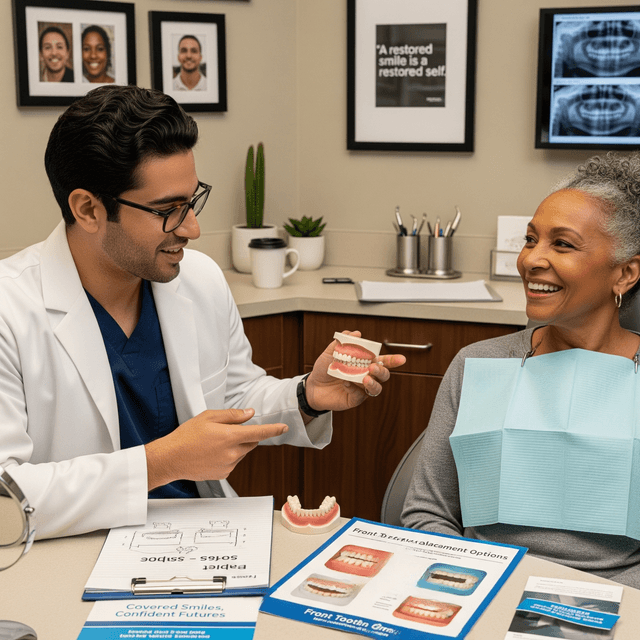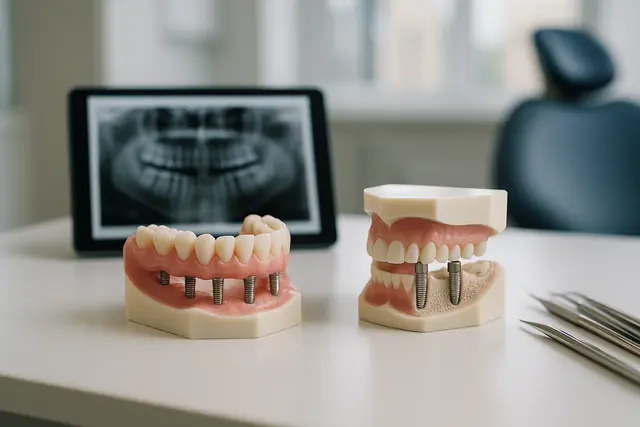Prosthodontics
5 min read
Sep 03, 2025
Permanent Front Tooth Dental Bridge: How It Restores Your Smile
A missing front tooth can impact more than just your appearance, it can affect your confidence, speech, and even how you eat. Fortunately, modern dental solutions like permanent dental bridges offer a reliable and natural-looking way to restore both function and aesthetics to your smile.

Nothing throws off your smile (and maybe your self-esteem) like a missing front tooth. You go from confidently grinning in photos to strategically hiding your teeth behind coffee mugs. Good news: a permanent front tooth dental bridge can change all that, bringing back your smile and helping you bite into an apple without worry.
Dental Bridge for a Front Tooth: What Is It, Really?
Imagine a dental bridge as a trusty stand-in for your missing tooth. It’s a custom dental appliance that literally “bridges” the gap left by one or more missing teeth. A dental bridge consists of an artificial tooth (called a pontic) held in place by healthy teeth (abutment teeth) or dental implants on either side. Dental bridges for front teeth are designed to blend in perfectly with your natural teeth, so no one has to know you’re sporting some extra hardware.
The bridge may replace a single tooth or multiple teeth, depending on your situation. Dental bridges are made to be strong, natural-looking, and comfortable, letting you chew, talk, and laugh like yourself again. And if you’re wondering about bridges for back teeth, they work much the same way but have to be even tougher to handle all that chewing.
Tooth Trouble: When Do You Need a Bridge?
Front teeth aren’t just for looks. They’re essential for:
Biting
Pronouncing words
Keeping your remaining teeth from shifting all over the place
When a tooth is missing (whether from an accident, decay, or a failed implant), it can set off a chain reaction. The rest of the teeth may start to move, changing your bite, and sometimes making things worse for your dental health. Plus, exposed teeth and gums can lead to extra sensitivity or even more tooth loss. Not the plot twist anyone wants.
A dental bridge is often the go-to solution when you have:
One missing tooth
Several teeth in a row
Even up to four missing teeth
It’s perfect for people who can’t or don’t want a dental implant and want a fixed, reliable solution instead of a removable partial denture.
Bridge Cost: What to Expect When You’re Budgeting
Let’s talk about the big question: how much does a dental bridge cost? The price can swing widely depending on:
The type of bridge
The number of teeth being replaced
The materials used
Your dental center’s team’s expertise
If you need a single tooth bridge, that’s usually less expensive than a bridge for multiple teeth. A fixed dental bridge for your front teeth is often made from high-quality ceramic to blend in with your natural teeth.
Bridge cost also depends on whether you’re pairing the bridge with dental implants or just using your existing teeth. And don’t forget dental insurance. Many plans cover a part of your dental bridge, especially if it’s medically necessary. Still, it’s always smart to ask your dental center’s team to check with your insurance provider before you commit.
Type of Dental Bridge for Front Teeth: Which One Is Best?
Not all bridges are the same, and picking the right type of dental bridge can feel like choosing toppings at a frozen yogurt shop (minus the sprinkles). Here are the main options:
Traditional Bridge: The most common choice, especially for front teeth. The dental bridge consists of an artificial tooth flanked by dental crowns on healthy neighboring teeth. This type of dental bridge is reliable, natural-looking, and long-lasting if you’ve got strong teeth on either side.
Cantilever Bridge: If you have healthy teeth adjacent to the missing tooth on only one side, a cantilever bridge does the job. It attaches to one tooth instead of two.
Maryland Bridge (Resin-Bonded Bridge): This option uses a metal or porcelain framework bonded to the backs of your natural teeth. Maryland bridges are often used for front teeth since they don’t require reshaping the adjacent teeth as much.
Implant-Supported Bridge: Here, dental implants act as anchors instead of your natural teeth. Dental implants can help when you’re missing multiple teeth or don’t want to put extra pressure on your remaining teeth.
Alternatives to Dental Bridges: Are There Other Options?
Of course, dental bridges aren’t the only solution to replace a missing tooth. You could get a dental implant, which involves surgically placing a titanium post into your jawbone and topping it with a dental crown. Dental implants can last a long time, and they don’t rely on the neighboring teeth to hold your bridge in place.
Another alternative is a removable partial denture, but most folks prefer the security and appearance of a permanent bridge for their front teeth. If you’re missing back teeth, sometimes a removable denture makes more sense. Bottom line: if you’re considering a dental bridge, ask your dentist which type of dental restoration matches your needs, budget, and lifestyle.
Bridge Right: How Does a Dental Bridge Work?
Getting a dental bridge is a team effort, with you and your dentist working together for the best results. First, the teeth adjacent to the missing tooth (the abutment teeth) are prepped. This might mean reshaping them slightly so the bridge fits snugly. Your dentist will take dental impressions to make a dental bridge that matches your bite and smile.
Next comes the temporary bridge to protect the exposed teeth and gums while your final bridge is being made at the dental laboratory. Once the new bridge is ready, your dentist will check the fit and color, making adjustments if needed, before cementing it in place. The bridge you receive should feel comfortable, look natural, and restore your confidence. And yes, you’ll be able to eat corn on the cob again.
Missing Teeth: Why a Bridge Matters More Than You Think
A permanent dental bridge doesn’t just replace one missing tooth. It also prevents the rest of your teeth from shifting, supports your facial shape, and keeps your dental health in top form. Bridges can last for many years with proper dental care and regular checkups. Plus, they feel so much like your natural teeth that you’ll probably forget you have a bridge right up until someone compliments your smile.
Getting a Dental Bridge: What to Expect at Your Dental Center
When you’re ready for a new dental bridge, your dental center will guide you through the process of getting a dental bridge from start to finish. This includes:
An initial consultation
Digital dental impressions
Prepping your teeth
Fitting a temporary bridge
Placing your fixed bridge
The temporary bridge will be removed when your permanent bridge is ready.
Take care of your new bridge with good oral hygiene, regular dental care, and checkups. Avoid chewing on super hard foods, and don’t use your teeth to open chip bags (we’ve all done it, but still). With a little TLC, dental bridges can last a decade or more.
What Is a Permanent Front Tooth Dental Bridge?
A permanent front tooth dental bridge is a fixed dental restoration used to replace one or more missing front teeth. It consists of an artificial tooth (pontic) anchored by crowns on the surrounding natural teeth or dental implants. Because front teeth are highly visible, bridges for this area are crafted from materials like porcelain or ceramic to ensure they look natural and blend seamlessly with your smile.
When Do You Need a Dental Bridge for Your Front Teeth?
A dental bridge is recommended when you are missing a front tooth due to injury, decay, or failed treatment. Beyond appearance, front teeth are vital for biting, speaking clearly, and preventing surrounding teeth from shifting out of alignment. Without replacement, missing teeth can lead to bite changes, speech issues, and long-term dental health problems. A bridge helps restore both function and confidence.
What Types of Dental Bridges Are Best for Front Teeth?
The most common options include:
Traditional Bridge: Uses crowns on both sides of the missing tooth for strong, reliable support.
Cantilever Bridge: Attached on only one side, suitable if only one adjacent tooth is available.
Maryland Bridge: Uses a resin-bonded framework, ideal for minimal preparation of nearby teeth.
Implant-Supported Bridge: Anchored by implants instead of natural teeth, offering maximum stability.
Your dentist will recommend the best type based on your oral health, number of missing teeth, and long-term goals.
How Much Does a Permanent Front Tooth Bridge Cost?
The cost of a front tooth dental bridge depends on the type of bridge, number of teeth replaced, and materials used. On average, prices range between $1,000 and $3,000 per tooth. Bridges supported by implants may cost significantly more due to surgical procedures and additional components. Many dental insurance plans cover part of the cost if the bridge is considered medically necessary, but checking coverage limits and exclusions is important.
Read Next
Related Posts

Prosthodontics
Implant Supported Dentures Overview
Missing teeth can impact more than just your smile, they can affect your confidence, comfort, and even your diet. Fortunately, modern dentistry offers a solution that’s both secure and natural-looking: implant-supported dentures. This innovative approach blends the stability of implants with the convenience of dentures to create a long-lasting, life-improving upgrade.
5 min read
Oct 29, 2025

Prosthodontics
Implant Overdentures Explained: The Hybrid Solution to Missing Teeth
Missing teeth can impact everything from your ability to eat to your self-confidence. While traditional dentures have long been a go-to solution, they often fall short in comfort and stability. Implant overdentures offer a modern alternative that combines the security of dental implants with the convenience of removable dentures, a true upgrade for those looking to reclaim their smile.
6 min read
Oct 29, 2025

Prosthodontics
Implant Retained Dentures Explained
Considering implant-retained dentures? You're not alone. As modern dentistry evolves, more people are turning to this secure, natural-feeling alternative to traditional dentures. This guide will walk you through what they are, how they work, and why they might be the solution you've been looking for.
4 min read
Oct 28, 2025
Don’t have time to research every dentist around you?
See why 30k+ patients trusted us